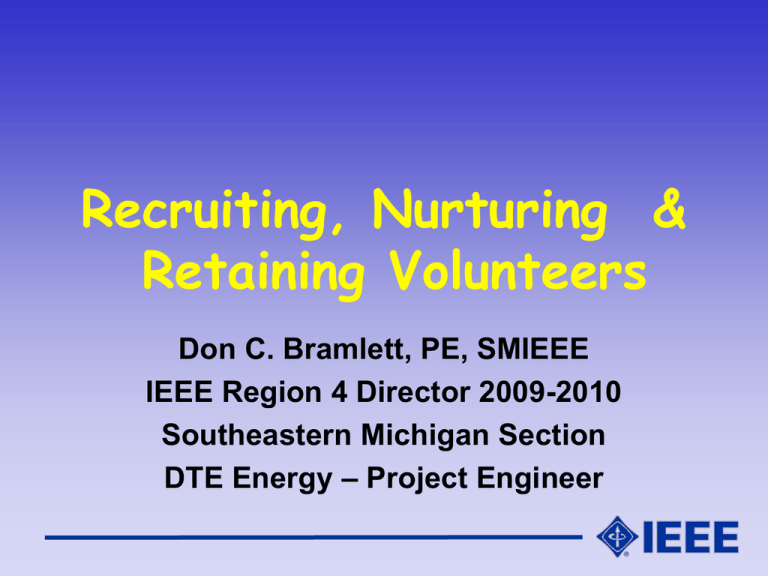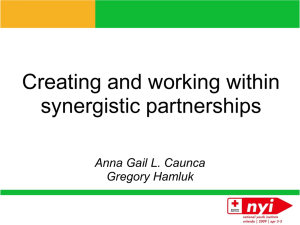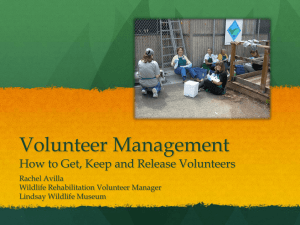IEEE Volunteers Presentation PPT
advertisement

Recruiting, Nurturing & Retaining Volunteers Don C. Bramlett, PE, SMIEEE IEEE Region 4 Director 2009-2010 Southeastern Michigan Section DTE Energy – Project Engineer Who is Volunteering • 49% of American adults volunteered 1995 • Over 50% of American between 25 and 54 years old • 45% of all American men and 52% of all American women • Increases with education attained, over 70% of college graduates volunteered an average of 4.8 hours a week • Increases with household income, 69% with income over $100,000 Type of Organizations • People are most likely to volunteer for charitable and community service projects; many people want to “make a difference” or help to solve a problem • Many trade and professional organizations, like IEEE, are finding it difficult to compete for their members’ volunteer time; numbers diminishing Reference Resource “Volunteers: How to Get Them, How to Keep Them” By Helen Little Panacea Press, Inc. Naperville, IL 1999 Needs of a Volunteer • A specific manageable task with a beginning and an end • A task that matches the interests and reasons for volunteering • A good reason for doing the task • Written instructions • A reasonable deadline for doing the task Needs of a Volunteer • Freedom to complete the task when and where it is most convenient for the volunteer • Everything necessary to complete the task without interruption • Adequate training • A safe, comfortable and friendly working environment Needs of a Volunteer • Follow-up to see that the task is completed • An opportunity to provide feedback when the task is finished • Appreciation, recognition and rewards that match the reasons for volunteering • Value added to encourage employer support of volunteer efforts A specific manageable task with a beginning and an end • Position/Job/Task Specification: Specific Roles - Written Job Descriptions, Instructions and/or Work Directions – Skills – Knowledge – Experience – Responsibilities - Duties – Time Commitment - Schedule • Making the Appeal – Ask for help personally – Personal contacts, Meeting attendees, etc A task that matches interests and reasons for volunteering • Volunteer motivations – Affiliation – Power - Recognition – Professional Growth - Networking • Determine volunteer interest – Polls – Surveys – Interview volunteers A good reason for doing the task • Work or task should be important to the functioning of the organization • Volunteer must feel he/she is making a meaningful contribution • TEAM – Together Each Achieves More • Will lead to a greater level of commitment to the task Written Instructions • • • • Job Description Work Directions Detailed Instructions Letters of appreciation and thanks A reasonable deadline for doing the task • Establish a schedule, interim milestones and deadline for completion of a task • Mentor and follow-up with the volunteer on progress to completion of a task Freedom to complete the task when and where it is most convenient for the volunteer • Avoid inefficient, time-consuming and wasteful face-to-face meetings • Make use of conference calls and communication technologies • Provide the volunteer flexibility • Monitor progress of the volunteer Needs everything necessary to complete the task without interruption • Plan the work and work the plan • The 5Ps – Proper Planning Prevents Poor Performance • Provide the needed materials and info early in the process • Increase the probability of success • Mentoring and support needed Adequate Training • Match training to the experience, needs and duties of the volunteer • Offer alternatives for training • Mentor and monitor volunteers • Annual Section & Chapter training A safe, comfortable and friendly working environment • Meeting locations need to be well identified, safe, secure and convenient • Volunteers need to feel welcome and be treated as valuable members of the team • Mentor and monitor volunteers • Provide for special needs • Volunteers will have a more positive image of the organization Follow-up to see that the task is completed • Volunteers are colleagues & partners, not subordinates or employees • Give opportunity to perform • Monitor and provide feedback • Be a coach and cheerleader • Mentor and counsel, as needed • Fire a volunteer, if necessary Opportunity to provide feedback when the task is completed • • • • • • Solicit feedback from volunteers Volunteers value the opportunity After Action Review (AAR) process Lessons learned opportunity Learn about problems encountered Prevent potential problems in the future and loss of volunteers Appreciation, recognition and rewards that match the reasons for volunteering • One of the easiest and least expensive needs of a volunteer • Thank each volunteer personally • Publicly recognize volunteers, as appropriate, in a timely manner • Provide a position with more authority and responsibility Value added to encourage employer support of volunteer efforts • Professional Development of Employee: Leadership, Project Management, Oral Presentation, Communication, Team Building, & Management Skills • Technical Development of Employee in training and educational forums • Exposure to state-of-the-art technology • Potential Impact on Industry Standards Long Term Benefits • Meeting volunteer needs creates a win– win situation • Volunteers benefit when you understand and meet their needs • The organization benefits too • A more successful organization • More long-term productive volunteers & more active members











